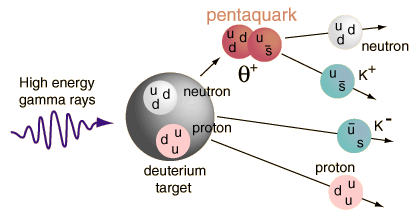Pentaquark
In 2003 came experimental evidence of a five-quark combination which is being called a pentaquark. Strong evidence for the pentaquark came from experiments at the Jefferson Lab in Newport News, Virginia during 2003. The experiments involved multi-GeV photons impacting a deuterium target. The evidence showed a five-quark baryon state at a mass of 1.54 GeV with a narrow width of 22 MeV. The new particle is being called Theta-plus, with a composition of two up quarks, two down quarks and an anti-strange quark. The combination of quark charges +2/3(u), -1/3 (d) and 1/3 (anti-strange) gives a net charge of +1. The lifetime of the particle is about 10-20 seconds. The decay is classified as a strong interaction decay to a neutron and a K+ meson

The Jefferson Lab results corroborated the growing body of evidence for the pentaquark from the last few years. Work done by a Japanese team led by Takashi Nakano of Osaka University involved bombarding a carbon target with X-rays and led to a report of pentaquark evidence in 2002. A retrospective study of 1986 bubble chamber experiments at ITEP in Moscow also revealed a 1.54 GeV peak. A review of data taken in 1997/98 at the ELSA accelerator in Bonn, Germany showed evidence of a particle of mass 1.54 GeV and width less than 25 MeV. The existence of the pentaquark was hypothesized by Maxim Polyakov, Dmitri Diakonov, and Victor Petrov at the Petersburg Nuclear Physics Institute in Russia in 1997.
| Table of Baryons | Table of Mesons |
| Table of quark properties |
Particle concepts
Reference
Schwarzschild
| HyperPhysics***** Quantum Physics | R Nave |